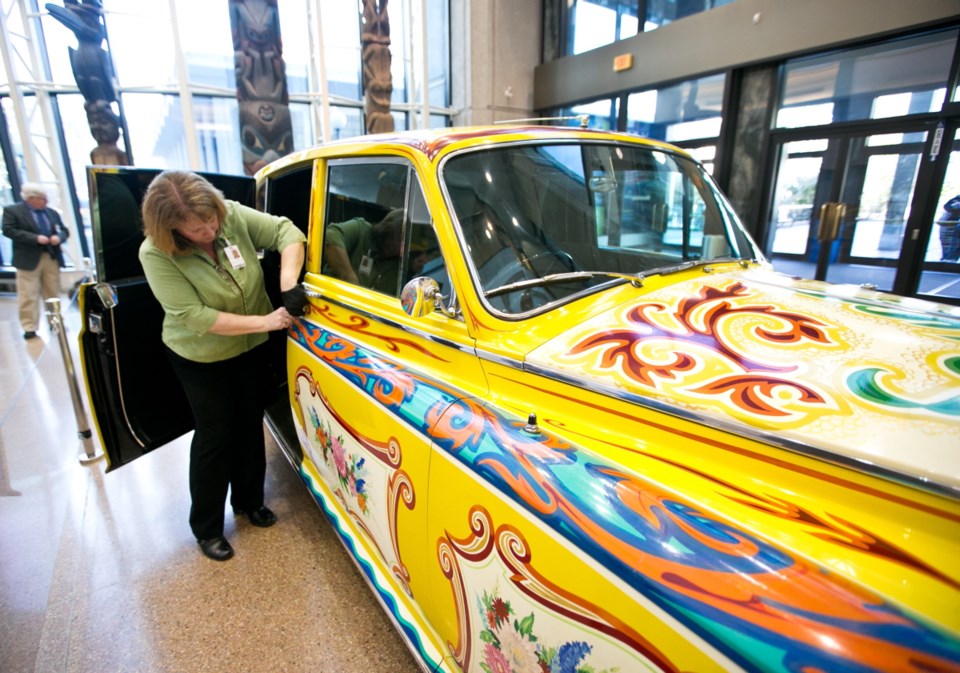John Lennon’s flower-emblazoned Rolls-Royce limousine was rolled off a flatbed truck, driven a short distance, and pushed into the lobby of the Royal B.C. Museum on Tuesday.
The famous Phantom V touring limousine that once delivered the Beatles to Buckingham Palace in 1965 — the Fab Four received medals from the Queen — spat out plumes of white smoke as it was driven to the museum’s doors.
“It’s a canvas with a motor,” museum curator Lorne Hammond said of the 3,000-kilogram vehicle. “It’s a complicated thing to manage.”
Regarded as a treasured piece of Beatles’ history and exhibited throughout North America for more than 20 years, the well-oiled machine will be displayed in the museum’s lobby until April 28.
Kasey Lee, conservation manager at the museum, said she barely slept Monday while going over the logistics of transporting the vehicle from a warehouse — in an undisclosed area in Greater Victoria — to the museum.
The paint is fragile and any condensation would have played havoc with it. A tarp would scratch it. An accident would be disastrous.
“It gives me more headaches than any other piece in our collection,” Lee said.
Object conservator George Field has the white-knuckle pressure of backing up the limousine with its opaque tinted windows and mirrors mounted on the hood.
“I’m driving a piece of history,” Field said. “I know John Lennon sat behind the wheel and I know probably each of the Beatles touched the hood ornament.”
The smoke from the car was caused by condensation, Field said, noting it runs surprisingly well. “It’s pretty happy right now.”
At the museum, the vehicle will sit behind a modest Plexiglas barrier — allowing people to get unobstructed selfies while protecting the limousine’s cracking and flaking Latex-paint surface from touchy fans, Hammond said.
The limousine was a dignified black when it was purchased by Lennon for tax purposes in December 1964. Lennon didn’t have a driver’s licence at the time.
But just prior to the release of the Beatles’ eighth studio album, Sgt. Pepper’s Lonely Hearts Club Band, the car went through an epic transformation: Artist Steve Weaver was commissioned to paint his scroll-and-flowers design.
Hammond, who has studied the car for almost two decades, said the artwork reflects the mood and time of Sgt. Pepper’s Lonely Hearts Club Band and the follow-up Magical Mystery Tour.
“It’s very tightly connected,” he said.
To the uneducated eye, the metal canvas just looks like scroll-framed flowers on a bright yellow background. To some artists, it represents a so-called Gypsy style with elements of the psychedelic era.
Hammond said it was first thought the painting was done by the Dutch design collective The Fool. Further research uncovered the newly painted limousine was delivered to Lennon 10 days prior to the release of the Sgt. Pepper concept album in June 1967. That’s significant, Hammond said.
“The work that Lennon and the Beatles were doing and the idea of redesigning the car appear to be interwoven,” Hammond said. “It’s the world of 1967 from the Beatles’ perspective.”
The black-on-black interior of the limousine was outfitted with a privacy partition, fold-out bed and tinted windows. It also had a 45 r.p.m. record player, an eight-track tape deck, a Sony television, a radio-phone and a portable fridge.
It still has the bed and record player today, but most of the electronics have been removed.
In 1970, Lennon and wife Yoko Ono took the car to the United States.
They donated it to a museum in 1974. The vehicle was offered at a Sotheby’s Auction in 1985, and was sold for $2.3 million US to B.C. business entrepreneur Jimmy Pattison.
It was on display at Expo 86 in Vancouver and was donated to the province in 1987 for a museum exhibit and to generate tourism. It was last at the Royal B.C. Museum in 2011.
“It’s a mural, it’s exotic,” Hammond said. “It’s a world-class object and can be found only in B.C.”



